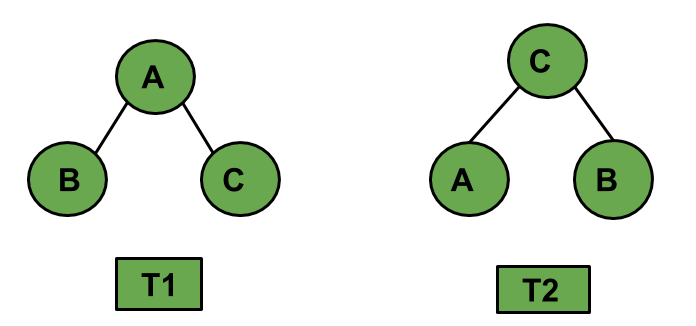有序树是定向树,其中节点的子节点以某种方式排序。它是一棵有根的树,其中为每个顶点的子级指定了顺序。之所以称为“平面树”,是因为子级的排序等效于树在平面中的嵌入,其根在顶部,每个顶点的子级都低于该顶点。
可以将有序树进一步指定为标记的有序树和未标记的有序树。
先决条件:加泰罗尼亚语数字|二项式系数。
标记的有序树:标记的树是一棵树,其中为每个顶点分配一个从1到n的唯一编号。

如果T1和T2是有序树。然后,T1 = T2,否则T1 = T2。
未标记的有序树:未标记的树是每个顶点都未标记的树。下面给出的是可能的未标记的有3个顶点的有序树。

具有n个节点的未标记有序树的总数等于第(n – 1)个加泰罗尼亚语数。
下面给出的是可能的未标记的有4个节点的有序树。该图将作为接下来的一些结果的参考示例。

1.恰好有k叶的树数。
让我们考虑一下,我们有一个’n’边。然后,对具有“ k”片叶子的所有可能的有序树的解由下式给出:

2.这些树中度为d的节点总数。
让我们考虑一下,我们有一个’n’边。然后,度为“ d”的节点总数的解由下式给出:

3.根的度数为r的树数。
让我们考虑一下,我们有一个’n’边。然后,由根给出度为“ r”的所有可能的有序树的解由下式给出:

下面是使用二项式系数的上述组合函数的实现:
C++
// C++ code to find the number of ordered trees
// with given number of edges and leaves
#include
using namespace std;
// Function returns value of
// Binomial Coefficient C(n, k)
int binomialCoeff(int n, int k)
{
int C[n + 1][k + 1] = { 0 };
int i, j;
// Calculate value of Binomial
// Coefficient in bottom up manner
for (i = 0; i <= n; i++) {
for (j = 0; j <= min(i, k); j++) {
// Base Cases
if (j == 0 || j == i)
C[i][j] = 1;
// Calculate value using
// previously stored values
else
C[i][j] = C[i - 1][j - 1] + C[i - 1][j];
}
}
return C[n][k];
}
// Function to calculate the number
// of trees with exactly k leaves.
int k_Leaves(int n, int k)
{
int ans = (binomialCoeff(n, k) * binomialCoeff(n, k - 1)) / n;
cout << "Number of trees having 4 edges"
<< " and exactly 2 leaves : " << ans << endl;
return 0;
}
// Function to calculate total number of
// nodes of degree d in these trees.
int numberOfNodes(int n, int d)
{
int ans = binomialCoeff(2 * n - 1 - d, n - 1);
cout << "Number of nodes of degree 1 in"
<< " a tree having 4 edges : " << ans << endl;
return 0;
}
// Function to calculate the number of
// trees in which the root has degree r.
int rootDegreeR(int n, int r)
{
int ans = r * binomialCoeff(2 * n - 1 - r, n - 1);
ans = ans / n;
cout << "Number of trees having 4 edges"
<< " where root has degree 2 : " << ans << endl;
return 0;
}
// Driver program to test above functions
int main()
{
// Number of trees having 3
// edges and exactly 2 leaves
k_Leaves(3, 2);
// Number of nodes of degree
// 3 in a tree having 4 edges
numberOfNodes(3, 1);
// Number of trees having 3
// edges where root has degree 2
rootDegreeR(3, 2);
return 0;
} Java
// java code to find the number of ordered
// trees with given number of edges and
// leaves
import java.io.*;
class GFG {
// Function returns value of
// Binomial Coefficient C(n, k)
static int binomialCoeff(int n, int k)
{
int [][]C = new int[n+1][k+1];
int i, j;
// Calculate value of Binomial
// Coefficient in bottom up manner
for (i = 0; i <= n; i++) {
for (j = 0; j <= Math.min(i, k); j++)
{
// Base Cases
if (j == 0 || j == i)
C[i][j] = 1;
// Calculate value using
// previously stored values
else
C[i][j] = C[i - 1][j - 1]
+ C[i - 1][j];
}
}
return C[n][k];
}
// Function to calculate the number
// of trees with exactly k leaves.
static int k_Leaves(int n, int k)
{
int ans = (binomialCoeff(n, k) *
binomialCoeff(n, k - 1)) / n;
System.out.println( "Number of trees "
+ "having 4 edges and exactly 2 "
+ "leaves : " + ans) ;
return 0;
}
// Function to calculate total number of
// nodes of degree d in these trees.
static int numberOfNodes(int n, int d)
{
int ans = binomialCoeff(2 * n - 1 - d,
n - 1);
System.out.println("Number of nodes "
+"of degree 1 in a tree having 4 "
+ "edges : " + ans);
return 0;
}
// Function to calculate the number of
// trees in which the root has degree r.
static int rootDegreeR(int n, int r)
{
int ans = r * binomialCoeff(2 * n
- 1 - r, n - 1);
ans = ans / n;
System.out.println("Number of trees "
+ "having 4 edges where root has"
+ " degree 2 : " + ans);
return 0;
}
// Driver program to test above functions
public static void main (String[] args)
{
// Number of trees having 3
// edges and exactly 2 leaves
k_Leaves(3, 2);
// Number of nodes of degree
// 3 in a tree having 4 edges
numberOfNodes(3, 1);
// Number of trees having 3
// edges where root has degree 2
rootDegreeR(3, 2);
}
}
// This code is contributed by anuj_67.Python3
# Python3 code to find the number of ordered
# trees with given number of edges and
# leaves
# Function returns value of
# Binomial Coefficient C(n, k)
def binomialCoeff(n, k):
C = [[0 for i in range(k + 1)]
for j in range(n + 1)]
# Calculate value of Binomial
# Coefficient in bottom up manner
for i in range(n + 1):
for j in range(min(i, k) + 1):
# Base Cases
if (j == 0 or j == i):
C[i][j] = 1
# Calculate value using
# previously stored values
else:
C[i][j] = (C[i - 1][j - 1] +
C[i - 1][j])
return C[n][k]
# Function to calculate the number
# of trees with exactly k leaves.
def k_Leaves(n, k):
ans = ((binomialCoeff(n, k) *
binomialCoeff(n, k - 1)) // n)
print("Number of trees ",
"having 4 edges and exactly 2 ",
"leaves : ", ans)
# Function to calculate total number of
# Nodes of degree d in these trees.
def numberOfNodes(n, d):
ans = binomialCoeff(2 * n - 1 - d, n - 1)
print("Number of Nodes ",
"of degree 1 in a tree having 4 ",
"edges : ", ans)
# Function to calculate the number of
# trees in which the root has degree r.
def rootDegreeR(n, r):
ans = r * binomialCoeff(2 * n - 1 - r, n - 1)
ans = ans // n
print("Number of trees ",
"having 4 edges where root has ",
"degree 2 : ", ans)
# Driver code
if __name__ == '__main__':
# Number of trees having 3
# edges and exactly 2 leaves
k_Leaves(3, 2)
# Number of Nodes of degree
# 3 in a tree having 4 edges
numberOfNodes(3, 1)
# Number of trees having 3
# edges where root has degree 2
rootDegreeR(3, 2)
# This code is contributed by aashish1995C#
// C# code to find the number of ordered
// trees with given number of edges and
// leaves
using System;
class GFG {
// Function returns value of
// Binomial Coefficient C(n, k)
static int binomialCoeff(int n, int k)
{
int [,]C = new int[n+1,k+1];
int i, j;
// Calculate value of Binomial
// Coefficient in bottom up manner
for (i = 0; i <= n; i++) {
for (j = 0; j <= Math.Min(i, k); j++)
{
// Base Cases
if (j == 0 || j == i)
C[i,j] = 1;
// Calculate value using
// previously stored values
else
C[i,j] = C[i - 1,j - 1]
+ C[i - 1,j];
}
}
return C[n,k];
}
// Function to calculate the number
// of trees with exactly k leaves.
static int k_Leaves(int n, int k)
{
int ans = (binomialCoeff(n, k) *
binomialCoeff(n, k - 1)) / n;
Console.WriteLine( "Number of trees "
+ "having 4 edges and exactly 2 "
+ "leaves : " + ans) ;
return 0;
}
// Function to calculate total number of
// nodes of degree d in these trees.
static int numberOfNodes(int n, int d)
{
int ans = binomialCoeff(2 * n - 1 - d,
n - 1);
Console.WriteLine("Number of nodes "
+"of degree 1 in a tree having 4 "
+ "edges : " + ans);
return 0;
}
// Function to calculate the number of
// trees in which the root has degree r.
static int rootDegreeR(int n, int r)
{
int ans = r * binomialCoeff(2 * n
- 1 - r, n - 1);
ans = ans / n;
Console.WriteLine("Number of trees "
+ "having 4 edges where root has"
+ " degree 2 : " + ans);
return 0;
}
// Driver program to test above functions
public static void Main ()
{
// Number of trees having 3
// edges and exactly 2 leaves
k_Leaves(3, 2);
// Number of nodes of degree
// 3 in a tree having 4 edges
numberOfNodes(3, 1);
// Number of trees having 3
// edges where root has degree 2
rootDegreeR(3, 2);
}
}
// This code is contributed by anuj_67.PHP
输出:
Number of trees having 4 edges and exactly 2 leaves : 3
Number of nodes of degree 1 in a tree having 4 edges : 6
Number of trees having 4 edges where root has degree 2 : 2时间复杂度: O(n * k)。
辅助空间: O(n * k)。
如果您希望与行业专家一起参加现场课程,请参阅《 Geeks现场课程》和《 Geeks现场课程美国》。